Table of Contents
Don’t save on the insulation
The main characteristics of three different thermal protection levels are dealt with in the following list. Taking no action will be much more expensive than carrying out insulation measures here and now! This is shown by the feasibility study (see Cost/Benefit Analysis). Good insulation saves money – and the better the level of insulation, the more money will be saved. The other features are also positively affected by good insulation:
- the risk of mould formation is reduced,
- thermal comfort is increased and there are better options for effective heating.
These are the advantages of good insulation which can be enjoyed by the owner and occupant themselves.
The European community will also benefit if energy is saved through better thermal protection:
- investment in thermal protection measures creates more employment in Europe and
- the reduced energy consumption will slow down climate change.
That is one of the reasons why the government in Germany provides financial assistance for subsequent thermal protection measures for buildings by offering the attractive subsidy programmes through the KfW Development Loan Corporation.
“ If you do it, do it right” is the principle which should be applied to thermal protection.
- No exterior painting and improvement of the render without applying insulation at the same time – it will be well worth it!
- Don't save on the insulation thickness! Some more insulation material won't cost that much – otherwise it won't be possible to increase the insulation for decades.
Level of thermal protection
| Level of thermal protection | Typical old external wall | Moderately insulated external wall | Good insulation |
|---|---|---|---|
| Illustration | 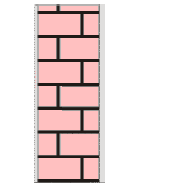 | 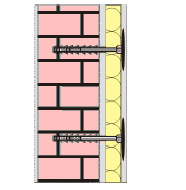 | 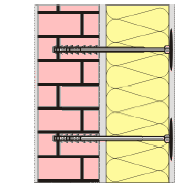 |
| Photograph (similar construction) | 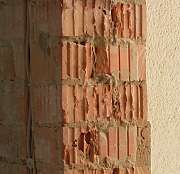 | 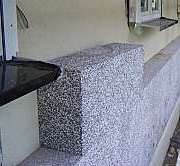 |
|
| Description (from outside to inside) | external plaster 24 cm perforated brick interior plaster | new external plaster 5 cm thermal insulation old external plaster 24 cm perforated brick interior plaster | new external plaster 25 cm thermal insulation old external plaster 24 cm perforated brick interior plaster |
| U-value1) | 1.4 W/(m²K) | 0.5 W/(m²K) | 0.125 W/(m²K) |
| Annual demand for heating oil (per 1 m² wall)2) | 12 l/m² | 4.3 l/m² | 1.1 l/²m |
| Remarks Heating oil: | Only oil companies are happy about that… | It won’t be possible to cover such high consumptions in a sustainable way in the future | or: 1/3 cubic metre of fuel wood for the whole external wall; this can be provided for everyone through sustainable forestry |
Interior surface temperatures
Heating load
| Level of thermal protection | Typical old external wall | Moderately insulated external wall | Good insulation |
|---|---|---|---|
| Heating load (proportion for 108 m² external wall)3) | 4.5 kW | 1.6 kW | 0.4 kW |
| Remarks Heating load: | One needs a heating machine just to cover this part of the heating load - and the corresponding installations for the ener- gy supply. | Still too much – just for compen- sating the heat losses through the external walls. | 400 Watt - the average heat gains from four persons. Good thermal protection provides the basis for very efficient heat provision. |
Cost/Benefit Analysis
| Level of thermal protection | Typical old external wall | Moderately insulated external wall | Good insulation |
|---|---|---|---|
| Annual energy costs (108 m² wall) 4) | 786 €/a | 277 €/a | 71 €/a |
| Production costs (1 m² wall) | 40 €/m² (only renewal of plaster) | 60 €/m² | 80 €/m² |
| Production costs (108 m² wall) | 4320 € | 6480 € | 8640 € |
| Annual repayment with interest 5) (108 m² wall) | 164 €/a | 246 €/a | 328 €/a |
| Annual total costs (108 m² wall) | 950 €/a | 523 €/a | 399 €/a |
| Remarks costs: | More than twice the cost of reasonable insulation levels – and more than double the earlier cost. | Still more than in the past – and unnecessarily more than it should be as shown in the column on the right. | That's how much it used to cost in the days of low fuel prices. |
Ecological analysis
| Level of thermal protection | Typical old external wall | Moderately insulated external wall | Good insulation |
|---|---|---|---|
| Primary energy for production (thermal insulation of 1 m² wall) | 0 | 16 kWh/m² (0.4% of the savings achieved) | 79 kWh/m² (1.5% of the savings achieved) |
| Primary energy saved (108 m² wall in 50 years) | 0 | 46 500 litres oil | 56 900 litres oil |
| CO2 emissions from production (thermal insulation for 1 m² wall in kg) | 0 | 5 kg/m² (0.4% of the savings achieved) | 26 kg/m² (1.5 % of the savings achieved) |
| CO2 emissions due to utilisation (108 m² wall in 50 years) | 203 100 kg | 71 500 kg | 18 500 kg |
| Remarks Climate Protection: | More than 200 tons of CO2 emissions are due just to the heat loss from exter- nal walls in this typical single-family house. That gives off as much CO2 as the whole house weighs. | 65% of the CO2 emissions can be avoided by using thermal insulation panels which weigh about 54 kg altogether. | 91% of the CO2 emissions can be prevented by using thermal insulation panels which weigh about 270 kg altogether. The remaining emission is also high (18 tons). The remaining demand can however, be met through renewable energy sources. |
Climate protection was long regarded as a poor argument for personal decisions: why should one undertake something that benefits the whole community and not “only” oneself?
This view will change significantly in the coming years. Currently, the consequences of climate change stand out dramatically against the background of normal weather activity. These consequences not only concern the “community” but also each individual's scope of action. If no decision is taken to counteract this, this scope of action will be narrowed drastically.
Climate change is mainly caused by CO2 emissions. And over one third of this is due to the energy consumption for heating buildings. Thermal insulation is therefore a very effective method of mitigating the effects of climate change and preserving our scope of action in the future. This benefits the whole community as well as the individual.
Conclusion
Due to the greatly increased energy prices in the last few years, permanently high running costs are to be expected for all households. A cheaper energy supply in the future is currently not in sight. However, there are many opportunities for reducing the energy consumption while at the same time improving the building structure and comfort through better efficiency.
One of the most important and most successful methods is the improvement of thermal protection.
The external walls have the highest proportion of building envelope areas through which heat is lost, and in old building these losses are considerably high. That is why insulation of the external walls was shown in this example. Insulation of the ceilings, roofs, basement ceilings, and improved windows also offer an energy savings potential. Examples of refurbished old buildings show that at least 65%, and in most cases almost up to 90 %, of the heating energy can be saved through efficiency measures.
The feasibility calculation shows that in spite of the investment in the insulation measures for the subsequent application of a compound insulation system, a lot of money can be saved each year from the very start. If no insulation is applied, the costs will be alarmingly high, now and in the future. With a good level of insulation it will even be possible to keep overall expenses at the same level as in the nineties. In a way, “thermal insulation” provides heating energy at the former lower prices.
Insulation on the outside of the exterior wall also protects the building fabric, because the old supporting wall will then be protected from weather influences and will remain warm and dry. There will no longer be any risk of mould growth due to indoor humidity. This also means an increase in the value of the building – however this was not taken into account for the feasibility calculation above.
In addition, the improved comfort is even more significant, because the interior surfaces remain pleasantly warm even at extremely cold outdoor temperatures – and the external walls do not heat up so much during extremely hot temperatures.
Recommendation: it’s better to insulate sooner than later – and if it has to be done, then it should be properly done - this means: really thick insulation.
See also
Superior thermal protection is affordable: A more comprehensive description of the economic efficiency of thermal protection.
For now: the U-value has actually proved to be the decisive factor for heat loss. Built and functioning Passive Houses are the best proof of that: they hardly require any heating energy (Energy efficiency of the Passive House Standard: Expectations confirmed by measurements in practice).
The output of the heating system depends on the heating load.
Small heating loads can be dealt with easily: 400 watts of heat are provided by 4 light bulbs of 100 watts each.
For 4.5 kilowatts, even an ordinary fan heater is not enough, therefore a special high performance heat supply system is required.
The price for fuel oil was assumed to be 0.60 Euros per litre (this article was first published in 2006; in 2011 the energy prices have been more than 35% higher, but in 2016-2020 the average level of ~0.60 €/ltr were reached again. So, the price here was guessed quite well. In future it might be somewhat higher due to the need for an energy taxation). The marginal annual utilisation factor of the heating system was assumed to be 90 %.
Normally, the facade with the compound insulation system doesn't have to be renovated or painted any more often than other facades and the new coat of paint/improvement will not be more expensive than that for the normal plaster facade.
Often a loan from the KfW's (Development Loan Corporation) “CO2 programme is available with very low annual interest.

